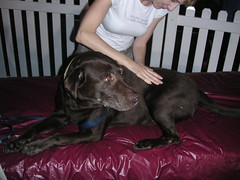 Frequently Asked Questions about the 2009 H1N1 Flu Virus and Pets
Frequently Asked Questions about the 2009 H1N1 Flu Virus and Pets
Updated November 6, 2009
These questions and answers are based on what is currently known about the virus, and will be updated as we get new information.
Q: Can my pet get the 2009 H1N1 virus?
A:Until recently, we had no reason to believe pets could be infected with the 2009 H1N1 virus because it is very uncommon for flu viruses to jump between species. However, on October 9, 2009, a USDA laboratory confirmed 2009/H1N1 infection in a ferret. The ferret’s owner had recently been ill with the flu. Ferrets are more susceptible to infection with influenza viruses, so this was not altogether surprising. At this time, there are no reports of the 2009 H1N1 flu virus being transmitted from a ferret to a person.
On November 4, the Iowa State Veterinarian and the Iowa Department of Public Health announced that a pet cat was confirmed infected with the 2009 H1N1 flu virus. The cat’s owners were ill and the cat developed respiratory symptoms shortly afterward. The cat has recovered and there is no evidence at this time that the cat passed the virus to any people.
Pets that live indoors, especially cats, tend to have close contact with their owners – after all, that’s why we have pets – and that increases their chances of being exposed to diseases. The best advice is to always follow common sense guidelines when dealing with animals (for example, washing your hands). In addition, it’s more important than ever that pet owners keep a good eye on their pet’s health and consult a veterinarian if their pet is showing any signs of illness. Keeping your pets healthy reduces their risk of becoming ill.
Q: I’ve heard about ferrets and a cat getting the 2009 H1N1 virus. Should I get rid of my ferret or cat so my family is protected?
A:Certainly not. This is not cause for panic and extreme measures. You are much more likely to catch the flu (any type of flu, including the 2009 H1N1 flu) from an infected person than you are from an animal. So far, all of the pets infected with the 2009 H1N1 virus became infected from being around their ill owners. The main lesson here is that if you’re feeling ill and have flu-like symptoms, you should probably limit your contact with your pets (and other people, for that matter) until you are feeling better. As always, if your pet is showing signs of illness, it should be examined by a veterinarian.
Q: The 2009 H1N1 virus has infected poultry. What about my pet bird? Can it be infected?
A:We know it can infect poultry, but we don’t know if it can affect other birds (including pet birds).
Q: What symptoms would I see in my dog or cat if it developed H1N1?
A:So far, there haven’t been any reports of dogs infected with the 2009 H1N1 flu virus. Based on what’s been reported, ferrets and one cat – and probably dogs, if they can become infected with the virus – have shown signs of respiratory illness. These signs can include lethargy, loss of appetite, fever, runny nose and/or eyes, sneezing, coughing, or changes in breathing (including difficulty breathing).
Keep in mind that dogs currently have their own flu virus, the H3N8 influenza (canine influenza) virus, going around. So far, this flu virus has only been spread from dog to dog. Dogs infected with the canine influenza virus show the same symptoms as dogs with kennel cough – fever, lethargy, loss of appetite, coughing, and maybe a runny nose. For more in-depth information on canine influenza, view our canine influenza backgrounder.
Q: How serious is this disease in dogs or cats?
A:We don’t yet know. There haven’t been any reports of dogs infected with the 2009 H1N1 flu virus, and there has only been one cat confirmed to be infected. The infected cat recovered from its illness.
Q:Should I keep the people in the house who have respiratory disease away from the pet and vice-versa?
A:Until we know more about the risks of spreading the virus from person to pet, pet to pet, or pet to person, it’s a good idea to limit contact between an ill family member and other family members and pets. If your pet is ill, contact your veterinarian.
Q: Is there a vaccine that can be used for pets? Can the human H1N1 vaccine be used for pets? What about the canine influenza vaccine?
A: There is not a licensed and approved 2009 H1N1 vaccine for pets. The human H1N1 vaccine should not be used for pets. The canine influenza vaccine, which protects dogs from the H3N8 flu virus, will not protect pets against the 2009 H1N1 virus and should not be used in any species other than dogs.
Q: Someone in my home is ill and may have the 2009 H1N1 virus. Should we board our pet(s) until this person has recovered?
A: That decision is really up to you. Your pet may have already been exposed to the virus by the time the family member starts showing symptoms, so it might not be best to uproot your pet, possibly stressing them, and put them in another environment. If you’re worried your pet may become infected with the influenza virus, treat your pet like you would any other family member – follow good hygiene when you come in contact with them, and limit their exposure to ill family members.
Q: Can my pot-bellied pig get the 2009 H1N1 virus and give it to me?
A: To date, the 2009 H1N1 virus has not been reported in pot-bellied pigs. However, the possibility of human-to-pig transmission of the virus warrants extra caution by pig owners. After all, pot-bellied pigs are considered swine, and therefore may be susceptible to the virus. For the time being, a cautious approach would include all contact between your pig and anyone who is ill or has recently been exposed to an ill person. Remember that pot-bellied pigs can become ill from a number of causes, and keeping your pig healthy and free of disease helps protect your pig as well as you. If you have a pet pig and it appears ill, consult a veterinarian immediately.
Here is the direct link to the page.

see more Lolcats and funny pictures
 Rose DeDan, a local shaman and healer, wrote a wonderful article today on her blog, The Dance of Life, The endless cycle of birth, death and our relationship to the food we consume. It give new meaning to the saying “you are what you eat.” She talks about the energetics of our food and how the way animals are raised can affect our health. We are all energetic beings and just as we take on the energy of those around us, we can also take on the energy of the animals we consume. If they have been treated well and fairly we end up with nutritious food, if they have not been it can lead to many health problems for us.
Rose DeDan, a local shaman and healer, wrote a wonderful article today on her blog, The Dance of Life, The endless cycle of birth, death and our relationship to the food we consume. It give new meaning to the saying “you are what you eat.” She talks about the energetics of our food and how the way animals are raised can affect our health. We are all energetic beings and just as we take on the energy of those around us, we can also take on the energy of the animals we consume. If they have been treated well and fairly we end up with nutritious food, if they have not been it can lead to many health problems for us. Food also has a temperature and other characteristics in Chinese Medicine. Trout is the hottest meat and a dog who is always cold would do well on it. Seaweed and Cucumber are considered cold and can cool a dog with excess heat. Sweet potato and pumpkin are sweet and help with digestion. Beef is good at tonifying the blood and helping with weakness. Carrots and other root vegetables are very grounding and help an animal be more connected to the earth.
Food also has a temperature and other characteristics in Chinese Medicine. Trout is the hottest meat and a dog who is always cold would do well on it. Seaweed and Cucumber are considered cold and can cool a dog with excess heat. Sweet potato and pumpkin are sweet and help with digestion. Beef is good at tonifying the blood and helping with weakness. Carrots and other root vegetables are very grounding and help an animal be more connected to the earth.
























